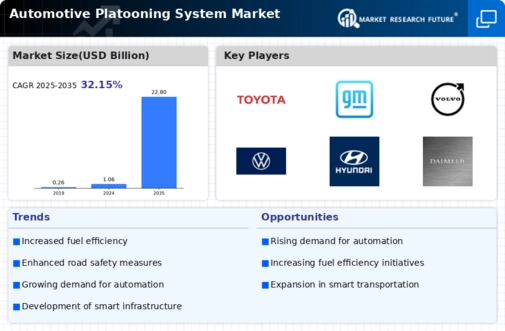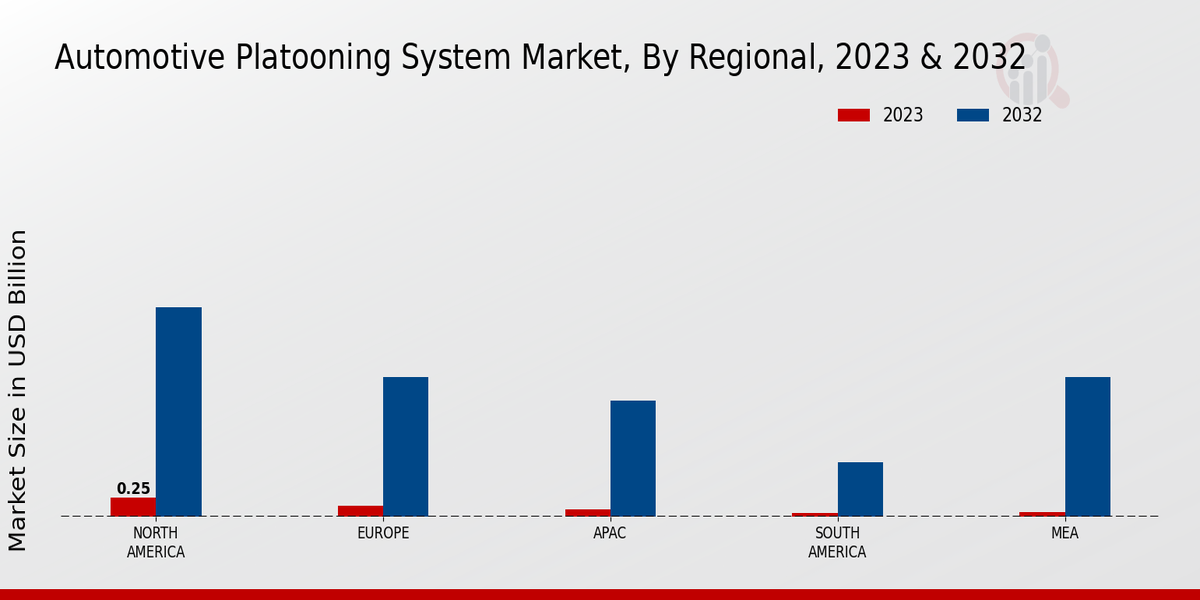Market Growth Projections
The Global Automotive Platooning System Market Industry is poised for substantial growth, with projections indicating a market size of 1.06 USD Billion in 2024 and an anticipated expansion to 22.8 USD Billion by 2035. This growth trajectory suggests a compound annual growth rate (CAGR) of 32.17% from 2025 to 2035. The increasing adoption of automated driving technologies, supportive government policies, and the rising demand for fuel efficiency are key factors contributing to this upward trend. As the market evolves, it is expected to attract significant investments and drive innovation, ultimately transforming the landscape of transportation.
Increased Focus on Road Safety
The Global Automotive Platooning System Market Industry is also driven by an increased focus on road safety. With the rising number of road accidents, stakeholders are prioritizing technologies that enhance safety for drivers and passengers. Platooning systems utilize advanced safety features such as collision avoidance and adaptive cruise control, which can significantly reduce the likelihood of accidents. By enabling vehicles to communicate and respond to each other in real-time, these systems create a safer driving environment. This emphasis on safety is likely to propel the adoption of platooning technologies, as consumers and fleet operators seek solutions that prioritize safety alongside efficiency.
Growing Demand for Fuel Efficiency
The increasing demand for fuel efficiency is a major driver of the Global Automotive Platooning System Market Industry. As fuel prices continue to fluctuate, fleet operators are seeking solutions that can minimize fuel consumption and operational costs. Platooning systems, which allow vehicles to travel closely together, can reduce aerodynamic drag and improve fuel efficiency by up to 10 percent. This efficiency not only lowers costs for operators but also contributes to environmental sustainability by reducing greenhouse gas emissions. As a result, the market is projected to expand significantly, with an anticipated growth to 22.8 USD Billion by 2035.
Rising Adoption of Electric Vehicles
The rising adoption of electric vehicles (EVs) is expected to influence the Global Automotive Platooning System Market Industry positively. As more consumers and businesses transition to EVs, the integration of platooning systems can enhance the operational efficiency of electric fleets. Platooning can optimize battery usage and extend the range of electric vehicles by reducing energy consumption through coordinated driving. This synergy between EV adoption and platooning technology is likely to attract investments and foster innovation in the market. Consequently, the industry may witness a compound annual growth rate (CAGR) of 32.17% from 2025 to 2035, reflecting the growing interest in sustainable transportation solutions.
Government Initiatives and Regulations
Government initiatives and regulations play a pivotal role in shaping the Global Automotive Platooning System Market Industry. Many countries are actively promoting the adoption of automated driving technologies through supportive policies and funding for research and development. For example, the European Union has set ambitious targets for reducing carbon emissions, which encourages the deployment of platooning systems that can optimize fuel consumption. Furthermore, regulatory frameworks are being established to ensure safety and interoperability among platooning vehicles. These efforts are likely to accelerate market growth, as they create a conducive environment for innovation and investment in this sector.
Technological Advancements in Vehicle Automation
The Global Automotive Platooning System Market Industry is significantly driven by rapid advancements in vehicle automation technologies. Innovations in sensors, communication systems, and artificial intelligence are enhancing the capabilities of platooning systems. For instance, the integration of Vehicle-to-Vehicle (V2V) and Vehicle-to-Infrastructure (V2I) communication enables vehicles to share real-time data, improving safety and efficiency. As these technologies evolve, they are expected to reduce operational costs and enhance fuel efficiency, making platooning more attractive to fleet operators. This trend is likely to contribute to the market's growth, with projections indicating a market size of 1.06 USD Billion in 2024.

















